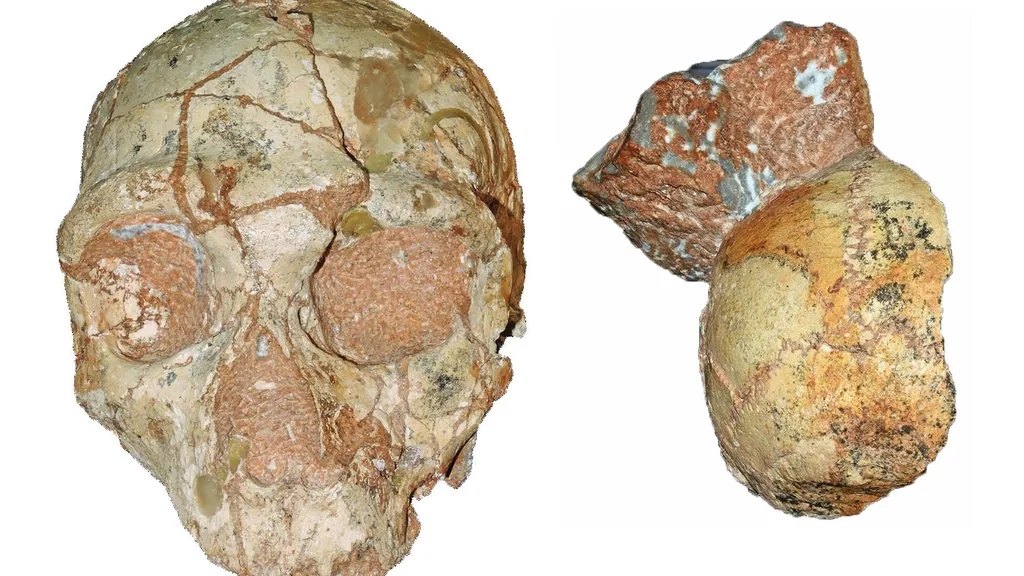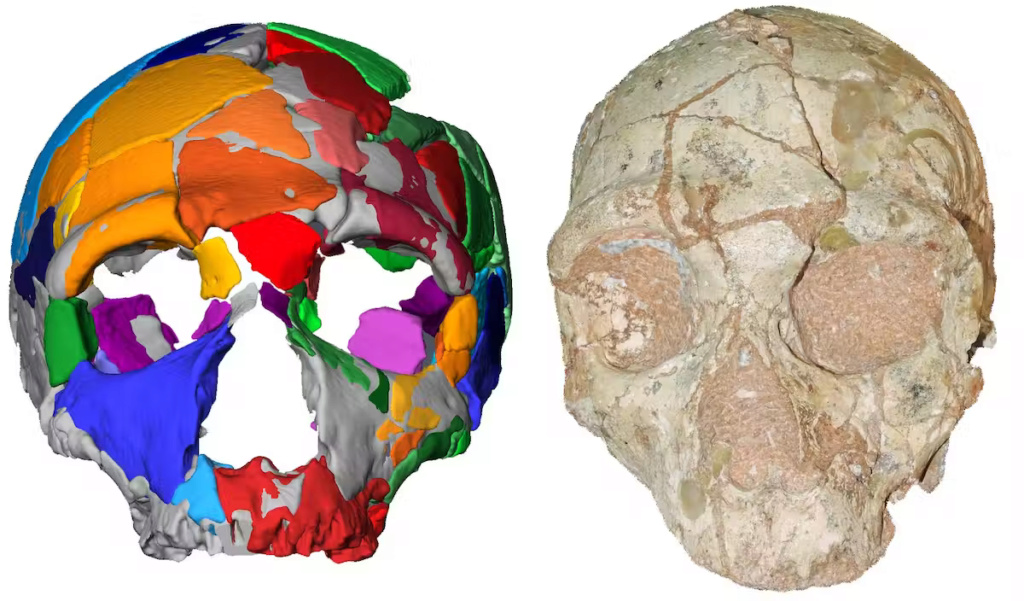This skull is the oldest human fossil ever discovered outside of Africa

These fragmented fossils discovered inches apart could be the skulls of two distinct species of hominini separated by tens of thousands of years: a 170,000-year-old Neanderthal (left) and potentially a human 210,000 year old modern.
A recent study argues that Homo sapiens was present in Greece 210,000 years ago and sparks intense debate among experts.
On the rugged coastline of southern Greece, our ancestors may well have stayed in what was once a gentle refuge from the glaciers that were slowly gaining ground in the Middle Pleistocene. While most of them disappeared without a trace, the skulls of two individuals meanwhile found their way to a crack in the ground where they ended up being cemented in a mixture of soil.
Hundreds of thousands of years later, the analyzes carried out on these remains point to an unsuspected identity: a skull fragment could have belonged to a modern man who lived at least 210,000 years ago, which makes him the oldest human fossil discovered outside the African continent .
“It's captivating! Comments by e-mail the main author of the study Katerina Harvati , a scientist attached to the Eberhard Karl University of Tübingen. “It's really gratifying to see that my hypotheses on the importance of the region in human evolution are supported by our results. »
If confirmed, this discovery will clarify the first movements of our species at a time when Homo sapiens sapiens left Africa to explore the world. However, many people have reservations about the strength of the evidence put forward.
"I see nothing that testifies to the belonging of this individual to the sapiens lineage ," observes Juan Luis Arsuaga , paleoanthropologist at the University of Madrid. The analysis he carried out in 2017 with his colleagues on a skull discovered not far from there had concluded that all the remains probably belonged to Neanderthals who walked the Earth around 160,000 years ago.
"I was totally stunned," he said of the team's provocative findings.

NEW TECHNIQUES FOR OLD FINDS
Unearthed in the 1970s, the skull fragments come from a wall of the cave of Apidima, a site located on the outskirts of Aeropoli, a town in the Peloponnese. The study of the Apidima fossils, as they are called, has not been without obstacles. First, the fragmented skulls were encased in their rocky matrix until the 1990s to 2000s. Even after being excavated from the rock, their identities were not immediately apparent.
One of the skulls was almost complete, although deformed by thousands of years in its rock casing. Still, a previous study had been able to attribute it to Neanderthal , which does not contradict this latest report. The second skull fragment was lodged a few centimeters in the rock and of a reduced size compared to the first, a unique piece barely larger than an adult palm. The previous study had therefore concluded that it was of the same species and of the same age as the first fragment. (Read: Neanderthal man: DNA analysis casts doubt on his migration. )
As part of the analyzes carried out on these enigmatic fossils, the scientists of the Museum of Anthropology of the University of Athens contacted Harvati to offer him to take part in the project. Eager to apply modern techniques to these famous fossils, she and her colleagues immediately jumped at the chance.
"It's a disturbing coincidence to find two skulls 30 cm apart," marvels study author Rainer Grün of Griffith University in Australia. “In the whole Greek territory, there is only one more skull and that's it, for this period. It is therefore a marvel of nature to find these two skulls together. »
Harvati and his team therefore scanned the fossils and then two of his team members worked separately on virtual reconstructions, with two different protocols in order to reduce the margin of error induced by the digital manipulation of the fossils. Finally, the scientists compared the features of the reconstructions to various Homo sapiens or Neanderthal skulls as well as Eurasian and African skulls dating from the Middle Pleistocene whose species is still debated.

TRY AGAIN AND AGAIN
The team was the first surprised by the results of its analysis carried out on the small skull fragment: it strangely resembled the skulls of modern humans.
Even though a skull fragment might be seen as very thin evidence for such a startling conclusion, it's worth remembering that the back of the head contains quite a bit of evidence pointing to Homo sapiens . It's almost as telling as the chin, a feature specific to Homo sapiens within hominids , notes paleoanthropologist Eric Delson of the City University of New York, not involved in the study but author of a paper l companion appeared in the journal Nature News and Views .
First, there is the form. If you run your hand over the back of your head, you should feel it curl like an orange. The head of Neanderthals, on the other hand, was more elongated, with a protrusion known as a bun. This elongation is not found on the Apidima skull fragment.
At this point the team decided to submit their results for publication and they were denied. At the time, researchers assumed that the proximity of the fossils indicated that they were both of the same age, dating back at least 160,000 years. However, there is no physical evidence of these populations in the area before at least 60,000 years ago, so the examiners were "understandably skeptical" that these fossils could be those of modern humans positioned so close to Neanderthal remains. , says one of the authors, Chris Stringer , of the Natural History Museum in London.
The team therefore redoubled their efforts to support their analyzes and attempt to date the fragment. To the (second) general surprise, their results suggested an age of around 210,000 years. If confirmed, the age of the fossils exceeds that of the previous oldest fossil of modern humans, an upper jaw fragment found in Israel and dated to around 180,000 years old . Furthermore, these fossils are said to be 150,000 years older than the previous oldest Homo sapiens fossils found in Europe .

THE EPIC OF THE HOMINIDS
If the team is correct, then Apidima's skull fragment will join the flood of evidence indicating that modern humans left Africa far earlier than originally thought. Until recently, it was thought that modern humans had taken some time before venturing outside the African continent and the origins of current populations were traced to a group of Homo sapiens who made this journey there . about 60,000 years ago.
By comparison, some ancient relatives of man had already reached central China 2.1 million years ago as evidenced by the stone tools they left behind . The ancestors of the small Homo floresiensis arrived in Southeast Asia 700,000 years ago. The predecessors of the Neanderthals set sail for Europe half a million years ago and split from their Denisovan cousins 400,000 years ago .
Harvati says this latest discovery suggests that modern humans had ventured much further north than the scientific community had previously imagined, and much earlier than expected. However, many scholars believe it is still too early to rewrite history.
“To be able to make such a statement, you would need a face,” Arsuaga points out.
In a 2014 study, Arsuaga and his colleagues had described a 430,000-year-old skull discovered in Spain in the Sima de los Huesos , or "pit of bones", whose face showed all the characteristics of Neanderthals without the typical elongation in the skull. Perhaps, similarly, the Apidima skull fragment was that of an early Neanderthal, he suggests. The authors of the new study admit that this is a possibility but they insist that the Apidima fragment is different from the bones of Sima de los Huesos and also different from other Neanderthal fossils of a similar age.
“As with any new debatable discovery, the appropriate initial reaction is reasonable skepticism, even when my own name appears on the report,” Stringer says. “We do not have the frontal bone, the brow bone, the face, the teeth or the chin which could all have been less characteristic of modern Man in their form. However, he insists on the numerous measures taken by the team to reduce the margins of error.
“Reconstructions are a bit of a cross between art and science,” observes Christopher Walker , a biological anthropologist at North Carolina State University. Although such analyzes may be influenced by expectations and the cranial models used for comparison, he acknowledges the conscientious work done by the team of scientists and admits that the skull fragment does indeed constitute a "mixture of features reminiscent of Homo know. »
On the other hand, Warren Sharp of the Berkeley Geochronology Center rejects dating the fragments so early and even goes so far as to call the results "imprecise and very scattered." Sharp is also dubious about the dating of the other oldest Homo sapiens fossil excavated in Israel and assures that it cannot date back more than 70,000 years .
“We give all the details in the article,” retorts Grün. “We didn't hide anything and our conclusions are, in my opinion, the best possible interpretation of the results. »
Anyway, whether or not Homo sapiens managed to reach Greece 210,000 years ago, it would seem that this group of scouts did not stick around long and that its members died without leaving their imprint in the genetic heritage of modern man. Clues to these enigmatic populations, however, may lie in DNA fragments found in Neanderthals reminiscent of the genome of Homo sapiens , the result of an earlier phase of reproduction between the two groups presumably dating back hundreds of thousands of years. years.

Perhaps the Apidima fossils belonged to a population that encountered and mated with our Neanderthal cousins, suggests Harvati. However, without further evidence, it is difficult to say where this population settled or how long it remained.
“We have a brief overview here,” concludes Delson. “Which clearly shows us that it would be useful to look elsewhere. »
Source : websites

